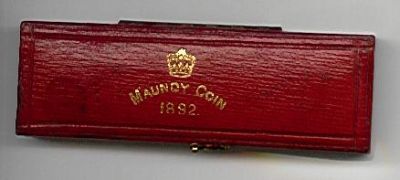Did you know?
It is generally accepted that from 1727 coins were minted just for the maundy ceremony.
1731 was the date when it was first recorded that all four coins were used in the maundy ceremony.
Maundy coins since 1822 remain legal tender. Their value is the stated value in new pence.
Maundy thursday can fall at anytime from 22nd March to the 25th April.
Gold Maundy Sets
1795 - 2 known ?
----------------------------------
1831 - Mintage 12? 5-10 known.
----------------------------------
1838 - Mintage 5-10
----------------------------------
1953 - Three sets known (one in Japan?).
----------------------------------
2002 - Elizabeth II Jubilee Mintage
Maundy thursday is also known as:
Kiss thursday
Birthday of the chalice
Birthday of the Eucharist.
Holy thursday(Europe)
Antlatz-Tag(Austria)
Green thursday(germany)
White thursday.
Copper Maundy Sets
1952 - 1 known.
Silver Maundy Sets
Most maundy sets were of course silver.
Hunt & Roskell London jewelers produced the maundy money from early 1852 to 1870s.
1831 3d Obverse shows bust of 2d.
1697 4d believed to be unique.
1921 - 1946 Silver content reduced.
Since 1957 a recipient at a maundy service is only allowed to attend once in their lifetime.
Milled maundy coins were made from Charles II reign.
The maundy service is only held in London every 10 years.
Maundy Thursday is the Thursday before Easter Sunday.
1927 was the first time the maundy and currency 3d were of different design.The currency 3d changed that year.
In 1960 the Queen mother distributed the maundy money as it was at the time of the birth of Prince Andrew.
1964 the Princess Royal distributed the maundy money on behalf of Queen Elizabeth II.
From Edward II to William & Mary the sovereign used to attend the maundy service every year.
From 1698 to 1931 no sovereign took part in the maundy ceremony.
The Cook islands issued a maundy set in 2002. It was the only issue of maundy coins outside the UK.
1961 was the first maundy service with 100% attendance.
All maundy coins are rare and are very undervalued at the present time.
For many of the early years only the silver penny was used in maundy services.
The first maundy coin was Scottish. It was a 4d from James IV. Only two specimens are known.
One is held in The British Museum.The other in the National Museum of Antiquities.
WHO SELECTS THE PEOPLE WHO RECEIVE MAUNDY MONEY EACH YEAR?
Generally the officials at the Cathedral where the service is held. There are sometimes exceptions to this.
The 1936 maundy distribution was made by the uncrowned Edward VIII on the 9th April 1936.
He subsequently abdicated on the 10th December 1936 before his coronation.
The 1936 maundy has the head of George V on it.
Maundy sets are very cheap compared to other coins based on mintage numbers.
The 4d (Groat) was first issued as an experiment in 1279. It was introduced as general currency from 1351.
The 3d (Quarter shilling) was introduced as currency in 1551.
The 2d (Half groat) was introduced as currency from 1351.
From 1727 coins were produced solely for the maundy ceremonies.
From 1957 a recipient at a maundy service is only allowed to attend once in their lifetime.
1911 Proof Sets - if you look at the maundy set included you will find it is not proof and the same as all other maundy sets
issued that year. There is though a slight variation to the 4d where the rim has a slightly different shape.
Cases were not normally given to maundy money recipients. They were sold separately for the benefit of the Royal Mint Self Help Society
later known as the Royal Mint Provident Society.

1892 Maundy Set case
The Jubilee bust was not used on Queen Victorias maundy money of 1887 as the ceremony was some weeks before the jubilee.
Prior to the reign of William Mary (1688-1694) only men or only women received maundy gifts according to the sex of the current monarch of the time.
Maundy 3d from 1845-1926 were indistinguishable from the silver 3d in ordinary circulation.
1765 George III 4d,3d & 2d are probably some of the most difficult to find and extremely expensive in any condition. No 1d was made that year.
1935 was King George V jubilee.A large number of maundy coins were bought by American visitors.
Maundy services not only take place in England but also several other European countries.
In 1837 King William IV agreed to pay recipients 30 shillings in lieu of provisions as he found that previously they were being sold for less
than they cost.
The design for the reverse of the maundy money is a crowned numeral in a wreath of oak leaves. This has been the same design since Charles II.
If you want to attend a maundy service you have to apply in writing to Royal Almonary, Buckingham Palace, London, England.
Dr Rowan Williams Archbishop of Canterbury performed the washing of the feet ceremony in 2003, the first time in over 400 years.
Edward VIII insisted his portrait faced to the left, the same as his father. This was the end of the custom of changing the direction
for each succesive monarch. The tradition had been in place since Charles II.
Why is the 1953 maundy set worth substantially more than similar years as mintage numbers (1025) about the same?
This was the coronation year for Queen Elizabeth II and not many sets come onto the market. Also in the legend it has BRITT OMN
which is unique compared to rest of series.
Mintage of maundy sets were limited in number from 1909.
Email : maundy@email.com